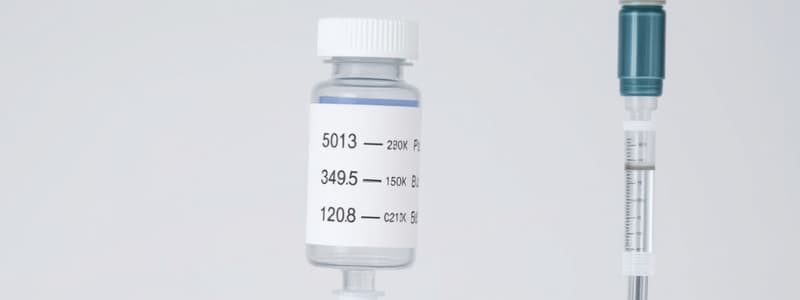Podcast
Questions and Answers
If an IV has a drip factor of 20 gtt/mL, how do you calculate drops per minute if the flow rate is 100 mL/hour?
If an IV has a drip factor of 20 gtt/mL, how do you calculate drops per minute if the flow rate is 100 mL/hour?
- Add drop factor to flow rate and divide by 60
- Divide by 60 and then multiply by 20
- Multiply by 60 and divide by drop factor
- Multiply flow rate and drop factor and then divide by 60 (correct)
Which formula should you use to calculate Body Surface Area (BSA)?
Which formula should you use to calculate Body Surface Area (BSA)?
- BSA (m²) = (height in cm + weight in kg) x 3600
- BSA (m²) = sqrt((height in cm x weight in kg) / 3600) (correct)
- BSA (m²) = sqrt((height in cm + weight in kg) / 3600)
- BSA (m²) = height in cm x weight in kg
Flashcards are hidden until you start studying
Study Notes
Dosage Calculations
- Basic Formula:
- Desired Dose / Available Dose x Quantity = Amount to administer
- Unit Conversions:
- Understand metric conversions (mg to g, mL to L).
- Familiarize with common conversions (1 g = 1000 mg, 1 L = 1000 mL).
- Dimensional Analysis:
- Use dimensional analysis for complex calculations by setting up conversion factors.
- Types of Medication Forms:
- Tablets, capsules, injections, and liquids.
- Pay attention to strength (e.g., 250 mg/5 mL).
- Calculating for Variability:
- Adjust dosages for patient weight (mg/kg).
- Adjust based on renal and hepatic function.
IV Flow Rates
- Calculation Formula:
- (Total volume in mL / Total time in hours) = mL/hour
- For drops/minute: (mL/hour x drop factor) / 60 = drops/minute
- Equipment Considerations:
- Understand different drip factors (e.g., microdrip vs. macrodrip).
- Know standard drop factors (e.g., 60 gtt/mL for microdrip).
- Infusion Rates Adjustment:
- Adjust rates based on patient response and clinical guidelines.
- IV Pump vs. Gravity:
- Familiarize with using IV pumps for precise control.
- Recognize when to switch to gravity flow and vice versa.
Pediatric Dosing
- Weight-Based Dosing:
- Commonly calculated in mg/kg.
- Always round doses appropriately for safety.
- Body Surface Area (BSA):
- Use BSA formula for medications with narrow therapeutic indices.
- BSA (m²) = sqrt((height in cm x weight in kg) / 3600).
- Age Considerations:
- Adjust dosages based on age (neonates, infants, children).
- Be aware of specific pediatric contraindications and special considerations.
- Safety Measures:
- Double-check calculations and verify with a second nurse.
- Utilize standardized dosing charts when available.
Dosage Calculations
- Basic formula for calculating medication dosage: Desired Dose divided by Available Dose multiplied by Quantity equals Amount to administer.
- Master metric conversions crucial for dosage calculations, including conversions between milligrams (mg) and grams (g) or milliliters (mL) and liters (L). Common conversions include 1 g = 1000 mg and 1 L = 1000 mL.
- Dimensional analysis serves as a structured approach for complex dosage calculations by utilizing conversion factors systematically.
- Common medication forms include tablets, capsules, injections, and liquids, each with distinct characteristics and considerations.
- When calculating doses, consider strength details, like 250 mg per 5 mL, to determine the correct administration amount.
- Patient-specific factors such as weight (mg/kg) and organ function (renal/hepatic) may necessitate dosage adjustments.
IV Flow Rates
- Formula to calculate IV flow rates: Total volume in mL divided by Total time in hours results in mL per hour; for drops per minute, multiply mL/hour by drop factor and divide by 60.
- Different drip factors must be understood, including variations like microdrip and macrodrip; for instance, a standard microdrip has a drop factor of 60 gtt/mL.
- Infusion rates should be adjusted based on the patient’s response and clinical practice guidelines to ensure safe and effective treatment.
- Recognize the differences between using an IV pump, which offers precise volumetric control, and gravity flow methods, adjusting as necessary.
Pediatric Dosing
- Pediatric dosing is primarily calculated using a weight-based approach, typically in mg/kg, requiring careful rounding to ensure safety.
- Body Surface Area (BSA) is important for medications with narrow therapeutic indices; BSA can be calculated using the formula: Square root of ((height in cm x weight in kg) divided by 3600).
- Dose adjustments should also consider age groups (neonates, infants, children), recognizing that physiological differences may affect medication efficacy and safety.
- Be vigilant for specific pediatric contraindications to avoid inappropriate medication use in younger populations.
- Implement safety measures, such as double-checking calculations with a second nurse and utilizing standardized dosing charts when available to prevent errors.
Studying That Suits You
Use AI to generate personalized quizzes and flashcards to suit your learning preferences.




